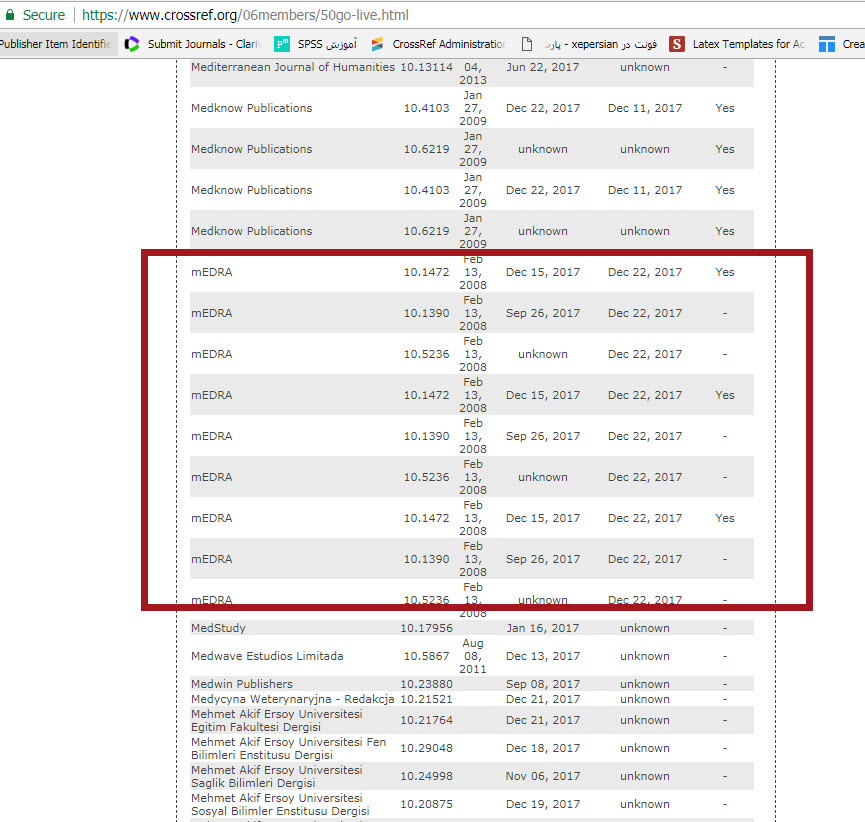Crossref makes research outputs easy to find, cite, link, and assess. We’re a not-for-profit membership organization that exists to make scholarly communications better.
It’s really important for consistency and usability that all members follow these guidelines. We rarely have to change them and usually only do so for very good reasons. Please note that this is for display of Crossref DOIs, not anyone else’s DOIs, as not all DOIs are made equal.
The goals of the guidelines are:
- To make it as easy as possible for users without technical knowledge to cut and paste or click to share Crossref DOIs (e.g. using right click to copy a URL).
- To get users to recognize a Crossref DOI as both a persistent link as well as a persistent identifier, even if they don’t know what a DOI is.
- To enable points 1 and 2 above by having all Crossref members display DOIs in a consistent way.
- To enable robots and crawlers to recognize Crossref DOIs as URLs.
This page includes the following sections:
- Display Crossref DOI as a full link
- Recent changes to guidelines
- Where to apply the display guidelines
- Crossref DOIs in reference lists and bibliographies
- ShortDOIs
- Frequently asked questions (FAQs)
Display Crossref DOI as a full link
Crossref DOIs should always be displayed as a full URL link in the form
https://doi.org/10.xxxx/xxxxx
and should not be preceded by doi: or DOI:.
Example: https://doi.org/10.5468/ogs.2016.59.1.1
Recent changes to guidelines
These new guidelines introduce two important changes that differ from the previous guidelines:
- we have dropped the
dxfrom the domain name portion of DOI links - we recommend you use the secure HTTPS rather than HTTP
Note this change is backwards compatible and http://dx.doi.org/ and http://doi.org/ will continue to work indefinitely.
Where to apply the display guidelines
Crossref DOIs should be displayed in the full URL wherever the bibliographic information about the content is displayed.
An obligation of membership is that Crossref DOIs must be displayed on members’ response pages (also called landing pages). We recommend that Crossref DOIs also be displayed or distributed in the following contexts:
- Tables of contents
- Abstracts
- Full text HTML and PDF articles, and other scholarly documents
- Citation downloads to reference management systems
- Metadata feeds to third parties
- “How to Cite This” instructions on content pages
- Social network links
- Anywhere users are directed to a permanent, stable, or persistent link to the content
Crossref members should not use proprietary, internal or other non-DOI URLs in citation downloads, metadata feeds to third parties, nor in instructions to researchers on how to cite a document.
Crossref DOIs in reference lists and bibliographies
Linking references in journal articles using Crossref DOIs is a condition of membership. We strongly encourage members to link references in other content types too. Because there are space constraints even in online references lists, Crossref DOIs can be displayed in several ways, depending on the publisher’s preference and publication style. Crossref recommends the following options:
Option 1 — use the Crossref DOI URL as the permanent link
Example: Soleimani N, Mohabati Mobarez A, Farhangi B. Cloning, expression and purification flagellar sheath adhesion of Helicobacter pylori in Escherichia coli host as a vaccination target. Clin Exp Vaccine Res. 2016 Jan;5(1):19-25. https://doi.org/10.7774/cevr.2016.5.1.19
Option 2 — display the text “Crossref” with a permanent DOI link behind the text
Example: Galli, S.J., and M. Tsai. 2010. Mast cells in allergy and infection: versatile effector and regulatory cells in innate and adaptive immunity. Eur. J. Immunol. 40:1843–1851. Crossref
ShortDOI
The International DOI Foundation created the ShortDOI service as an open system that creates shortcuts to DOIs. DOIs can be long, so this service aimed to to the same thing as URL shortening services. For example, for the DOI https://doi.org/10.7774/cevr.2016.5.1.1 the short form is https://doi.org/bwfc. Only one ShortDOI is created for each DOI, and the ShortDOI returns exactly the same results as the DOI. For more information go to http://shortdoi.org/. ShortDOIs are not widely used and are not really actual DOIs themselves, which is confusing. Ideally, we recommend simply creating shorter DOIs in the first place.
Frequently Asked Questions (FAQ)
Do we need to change how DOIs are displayed in already published content and existing PDFs?
No - you can make the change for new content going forward and do not need to update existing PDF files. You can update existing content if you want but this is optional. The current form, for DOI links using http://dx.doi.org, will continue to work as long as Crossref and the DOI system exist.
Can we make the display changes now or do we need to wait?
These guidelines are now in effect. We set the date as March 2017, after giving our members six months’ notice to make the changes.
Why does the DOI have to be displayed as a link on the page that the DOI links to?
Some members have reported resistance from colleagues to displaying the Crossref DOI on the landing page as a link (they say the DOI link in that location appears superfluous as it appears to link to itself). The Crossref DOI must be displayed as a link, because it is both an identifier and a persistent link. It is easier for users when members display the DOI as a full link as they can copy it easily. In addition, many users don’t know what a DOI is but they know what a link is. We want to encourage the DOI to be used as a persistent link, and to be shared and used in other applications (e.g. reference managers). A fully linked DOI wherever it appears, enables this.
Do we need to redeposit our metadata to update the URLs?
No - there is no need to redeposit metadata. These guidelines cover how you display DOIs on your website, not how to register them with us.
Why not use doi: or DOI:?
When Crossref was founded in 2000 we recommended that DOIs be displayed in the format doi:10.NNNN/doisuffix and many members still use doi:[space][doinumber], DOI: [space][doinumber], or DOI[space][doinumber]. At the time that the DOI system was launched in the late 1990s it was thought that doi: would become native to browsers and automatically resolve DOIs, similar to http:. This never happened and it will never happen. Advantages to changing the display to a resolvable URL - even on the page the DOI itself resolves to - include the following:
- A DOI is both a link and an identifier. Users will more easily recognize Crossref DOIs as an actionable link, regardless of whether they know about DOIs.
- Users who do not know how to right-click on the link and choose “Copy Link”, will still be able to easily copy the DOI URL.
- Machines and programs (e.g. bots, etc.) will recognize the DOI as a link, thereby increasing discoverability and usage.
What about reference formats in style guides (e.g. APA, Chicago) that use doi: [doinumber]?
A number of style guides recommend that a DOI be included in the reference as an unlinked string. We are contacting the main style guides to request that they update their recommendations for DOIs to use the full URL form.
Why not use dx as in http://dx.doi.org/?
Originally the dx separated the DOI resolver from the International DOI Foundation (IDF) website but this changed a few years ago and the IDF recommends http://doi.org as the preferred form for the domain name in DOI URLs.
Why should we use HTTPS?
Providing the central linking infrastructure for scholarly publishing is something we take seriously. Because we form the connections between publisher content all over the web, it’s important that we do our bit to enable secure browsing from start to finish. In addition, HTTPS is now a ranking signal for Google who gives sites using HTTPS a small ranking boost.
The process of enabling HTTPS on publisher sites will be a long one and, given the number of members we have, it may take a while before everyone’s made the transition. But by using HTTPS we are future-proofing scholarly linking on the web.
Some years ago we started the process of making our new services available exclusively over HTTPS. The Crossref Metadata API is HTTPS enabled, and Crossmark and our Assets CDN use HTTPS exclusively. In 2015 we collaborated with Wikipedia to make all of their DOI links HTTPS. We hope that we’ll start to see more of the scholarly publishing industry doing the same.






Comments